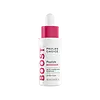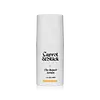What's inside
What's inside
 Key Ingredients
Key Ingredients

 Benefits
Benefits

 Concerns
Concerns

No concerns
 Ingredients Side-by-side
Ingredients Side-by-side

Water
Skin ConditioningGlycerin
HumectantPEG-8 Dimethicone
EmulsifyingTripeptide-1
Skin ConditioningPalmitoyl Tripeptide-1
Skin ConditioningPalmitoyl Tetrapeptide-7
Skin ConditioningPalmitoyl Hexapeptide-12
Skin ConditioningMyristoyl Hexapeptide-16
Skin ConditioningMyristoyl Pentapeptide-17
Skin ConditioningHexanoyl Dipeptide-3 Norleucine Acetate
Skin ConditioningAzelaoyl Bis-Dipeptide-10
Skin ConditioningGlycoproteins
Skin ConditioningPhospholipids
Skin ConditioningAdenosine
Skin ConditioningDipotassium Glycyrrhizate
HumectantArginine
MaskingValine
MaskingGlycine
BufferingAlanine
MaskingGlutamic Acid
HumectantSerine
MaskingThreonine
Yeast Extract
Skin ConditioningIsoleucine
Skin ConditioningProline
Skin ConditioningHistidine
HumectantPhenylalanine
MaskingPCA
HumectantPhytic Acid
Panax Ginseng Root Extract
EmollientSodium PCA
HumectantPsidium Guajava Fruit Extract
AstringentEuterpe Oleracea Fruit Extract
Ahnfeltiopsis Concinna Extract
Skin ConditioningDextran
Hydrolyzed Silk
HumectantLecithin
EmollientGlyceryl Polymethacrylate
C12-16 Pareth-9
EmulsifyingTrideceth-12
EmulsifyingSodium Lactate
BufferingCarbomer
Emulsion StabilisingAspartic Acid
MaskingPolysorbate 20
EmulsifyingButylene Glycol
HumectantCaprylyl Glycol
EmollientPEG-8
HumectantC11-15 Pareth-7
EmulsifyingGuar Hydroxypropyltrimonium Chloride
Skin ConditioningPhytosteryl/Octyldodecyl Lauroyl Glutamate
Skin ConditioningEctoin
Skin ConditioningCitrate Buffer
Trimethylsiloxyamodimethicone
Phenoxyethanol
PreservativeSodium Hydroxide
BufferingEthylhexylglycerin
Skin ConditioningWater, Glycerin, PEG-8 Dimethicone, Tripeptide-1, Palmitoyl Tripeptide-1, Palmitoyl Tetrapeptide-7, Palmitoyl Hexapeptide-12, Myristoyl Hexapeptide-16, Myristoyl Pentapeptide-17, Hexanoyl Dipeptide-3 Norleucine Acetate, Azelaoyl Bis-Dipeptide-10, Glycoproteins, Phospholipids, Adenosine, Dipotassium Glycyrrhizate, Arginine, Valine, Glycine, Alanine, Glutamic Acid, Serine, Threonine, Yeast Extract, Isoleucine, Proline, Histidine, Phenylalanine, PCA, Phytic Acid, Panax Ginseng Root Extract, Sodium PCA, Psidium Guajava Fruit Extract, Euterpe Oleracea Fruit Extract, Ahnfeltiopsis Concinna Extract, Dextran, Hydrolyzed Silk, Lecithin, Glyceryl Polymethacrylate, C12-16 Pareth-9, Trideceth-12, Sodium Lactate, Carbomer, Aspartic Acid, Polysorbate 20, Butylene Glycol, Caprylyl Glycol, PEG-8, C11-15 Pareth-7, Guar Hydroxypropyltrimonium Chloride, Phytosteryl/Octyldodecyl Lauroyl Glutamate, Ectoin, Citrate Buffer, Trimethylsiloxyamodimethicone, Phenoxyethanol, Sodium Hydroxide, Ethylhexylglycerin
Water
Skin ConditioningNiacinamide
SmoothingGlycerin
HumectantAcacia Senegal Gum
MaskingHydrolyzed Rhizobian Gum
Camellia Sinensis Leaf Extract
AntimicrobialChamomilla Recutita Flower Extract
MaskingPCA
HumectantSodium PCA
HumectantSh-Oligopeptide-1
Skin ConditioningSh-Oligopeptide-2
Skin ConditioningSh-Polypeptide-1
Skin ConditioningSh-Polypeptide-11
Sh-Polypeptide-9
Skin ConditioningSodium Hyaluronate
HumectantAcetyl Hexapeptide-8
HumectantArginine
MaskingAspartic Acid
MaskingAcetyl Glutamine
Skin ConditioningLecithin
EmollientCarnitine
CleansingAlanine
MaskingGlycine
BufferingHistidine
HumectantIsoleucine
Skin ConditioningPhenylalanine
MaskingProline
Skin ConditioningSerine
MaskingThreonine
Valine
MaskingCaffeine
Skin ConditioningRuscus Aculeatus Root Extract
AstringentChenopodium Quinoa Seed Extract
Skin ConditioningBacillus
Skin ConditioningCitrus Reticulata Peel Extract
Skin ConditioningCodonopsis Lanceolata Extract
AntioxidantCoix Lacryma-Jobi Ma-Yuen Seed Extract
Skin ConditioningChrysanthemum Parthenium Extract
Skin ConditioningDigitaria Ciliaris Flower Extract
EmollientGlycyrrhiza Glabra Root Extract
BleachingNelumbo Nucifera Seed Extract
AntimicrobialPaeonia Suffruticosa Root Extract
Skin ProtectingPaeonia Albiflora Flower Extract
TonicPolygonum Odoratum Extract
Skin ConditioningSodium Lactate
BufferingPolyglutamic Acid
Skin ConditioningXanthan Gum
EmulsifyingButylene Glycol
Humectant1,2-Hexanediol
Skin ConditioningCitric Acid
BufferingCaprylyl Glycol
EmollientSodium Benzoate
MaskingSodium Levulinate
Skin ConditioningPotassium Sorbate
PreservativePhenoxyethanol
PreservativeWater, Niacinamide, Glycerin, Acacia Senegal Gum, Hydrolyzed Rhizobian Gum, Camellia Sinensis Leaf Extract, Chamomilla Recutita Flower Extract, PCA, Sodium PCA, Sh-Oligopeptide-1, Sh-Oligopeptide-2, Sh-Polypeptide-1, Sh-Polypeptide-11, Sh-Polypeptide-9, Sodium Hyaluronate, Acetyl Hexapeptide-8, Arginine, Aspartic Acid, Acetyl Glutamine, Lecithin, Carnitine, Alanine, Glycine, Histidine, Isoleucine, Phenylalanine, Proline, Serine, Threonine, Valine, Caffeine, Ruscus Aculeatus Root Extract, Chenopodium Quinoa Seed Extract, Bacillus, Citrus Reticulata Peel Extract, Codonopsis Lanceolata Extract, Coix Lacryma-Jobi Ma-Yuen Seed Extract, Chrysanthemum Parthenium Extract, Digitaria Ciliaris Flower Extract, Glycyrrhiza Glabra Root Extract, Nelumbo Nucifera Seed Extract, Paeonia Suffruticosa Root Extract, Paeonia Albiflora Flower Extract, Polygonum Odoratum Extract, Sodium Lactate, Polyglutamic Acid, Xanthan Gum, Butylene Glycol, 1,2-Hexanediol, Citric Acid, Caprylyl Glycol, Sodium Benzoate, Sodium Levulinate, Potassium Sorbate, Phenoxyethanol
Ingredients Explained
These ingredients are found in both products.
Ingredients higher up in an ingredient list are typically present in a larger amount.
Alanine is an amino acid and is already found in the human body. Our skin uses alanine to build collagen, elastin, and keratin.
Arginine is an amino acid that is important for human development. Your body uses is it to produce hair keratin and skin collagen.
As a cosmetic ingredient, Arginine has antioxidant properties and can also help repair damaged skin. This ingredient is derived either synthetically or from animals.
Arginine isn't fungal acne safe when used in the presence of other lipids (fats, fatty acids, oils, esters, etc). Oils and fats occur naturally within the skin, so take caution when using Arginine if you're prone to fungal acne.
Learn more about ArginineAspartic Acid is an amino acid that our bodies produce naturally. It is an antioxidant.
Our body uses Aspartic Acid to help build collagen and elastin. It also plays a role in hydrating skin.
Butylene Glycol (or BG) is used within cosmetic products for a few different reasons:
Overall, Butylene Glycol is a safe and well-rounded ingredient that works well with other ingredients.
Though this ingredient works well with most skin types, some people with sensitive skin may experience a reaction such as allergic rashes, closed comedones, or itchiness.
Learn more about Butylene GlycolCaprylyl Glycol is a humectant and emollient, meaning it attracts and preserves moisture.
It is a common ingredient in many products, especially those designed to hydrate skin. The primary benefits are retaining moisture, skin softening, and promoting a healthy skin barrier.
Though Caprylyl Glycol is an alcohol derived from fatty acids, it is not the kind that can dry out skin.
This ingredient is also used as a preservative to extend the life of products. It has slight antimicrobial properties.
Learn more about Caprylyl GlycolGlycerin is already naturally found in your skin. It helps moisturize and protect your skin.
A study from 2016 found glycerin to be more effective as a humectant than AHAs and hyaluronic acid.
As a humectant, it helps the skin stay hydrated by pulling moisture to your skin. The low molecular weight of glycerin allows it to pull moisture into the deeper layers of your skin.
Hydrated skin improves your skin barrier; Your skin barrier helps protect against irritants and bacteria.
Glycerin has also been found to have antimicrobial and antiviral properties. Due to these properties, glycerin is often used in wound and burn treatments.
In cosmetics, glycerin is usually derived from plants such as soybean or palm. However, it can also be sourced from animals, such as tallow or animal fat.
This ingredient is organic, colorless, odorless, and non-toxic.
Glycerin is the name for this ingredient in American English. British English uses Glycerol/Glycerine.
Learn more about GlycerinThis ingredient is an amino acid that helps build proteins and moisturizes skin. It is already present in our skin as our bodies produce them naturally.
Glycine already plays a role in helping keep our skin moisturized as amino acids transport moisture throughout our skin.
As collagen is made up of glycine and other amino acids, it is believed glycine may help our skin produce more collagen.
Learn more about GlycineHistidine is a semi-essential amino acid used by our bodies to create protein. It has humectant and skin conditioning properties.
Our bodies use histidine to create filaggrin - filaggrin is a structural protein that the skin uses in maintaining skin barrier.
One study found histidine and carnosine to be a dynamic duo for your skin:
Oral histidine has also been found to help with filaggrin-deficit skin disorders such as atopic dermatitis.
Why is it considered a semi-essential amino acid? This is because adults are able to create it but children must get it from their diet.
Learn more about HistidineIsoleucine is an amino acid that helps reinforce our skin barrier. This amino acid plays a role in creating protein for the body.
Fun fact: Isoleucine is found in meat, fish, dairy, legumes, and nuts.
Lecithin is a term for a group of substances found in the cell membranes of plants, animals, and humans. They are made up of mixture of phospholipids.
This ingredient has emollient and emulsifying properties.
As an emollient, lecithen helps soften the skin and creates a barrier to keep moisture in.
As an emulsifier, it also helps prevent water and oil ingredients from separating. Lecithin can also help ingredients be better absorbed by the skin.
This is because the phospholipids in lecithin produce liposomes. Liposomes help other ingredients get through the skin barrier.
Depending on the source of this ingredient, lecithin may not be fungal acne safe. This is because some sources of lecithin come from soybean oil, which may feed the malassezia yeast that feeds fungal acne.
We recommend reaching out to the brand you are purchasing from to inquire about the source of their lecithin.
Some other names for this ingredient include soy lecithin and deoiled soy lecithin.
Learn more about LecithinPCA is derived from amino acids and is naturally found in our skin's barrier.
As a humectant, PCA helps draw and hold moisture to the skin. Studies show it is effective at helping the skin stay hydrated long-term.
Phenoxyethanol is a preservative that has germicide, antimicrobial, and aromatic properties. Studies show that phenoxyethanol can prevent microbial growth. By itself, it has a scent that is similar to that of a rose.
It's often used in formulations along with Caprylyl Glycol to preserve the shelf life of products.
Phenylalanine is an amino acid. It is a skin soothing and hydrating ingredient. Amino acids play a crucial role in wound healing and skin hydration.
This ingredient is also used to help even out skin tone due to its ability to disrupt the melanin production process.
Two structures of phenylalanine exist: L-phenylalanine and D-phenylalanine. L-phenylalanine is essential, this means our bodies cannot produce it naturally and we must get it from foods. Our bodies convert D-phenylalanine to neurotransmitters, and D-phenylalanine is found in our bodies naturally.
Some foods that contain L-phenylalanine include eggs, soybeans, beef, milk.
Learn more about PhenylalanineProline is an amino-acid. It helps moisturize the skin and plays an important role in creating proteins.
Our skin uses proline as one of the building blocks for producing collagen.
In medicine, proline is used as an osmoprotectant. This means it helps prevent oxidative degradation in other drugs.
Our bodies are able to produce proline naturally, but certain conditions may inhibit this production. In that case, proline can be obtained from eating egg whites, soy protein, dairy products, asparagus, mushrooms, and seaweed.
Learn more about ProlineSerine is an amino acid naturally found in our body. Our bodies use amino acids to create protein.
Amino-acids help give keep our skin hydrated. They play an important role in the skin barrier, which keeps the skin plump and firm.
Serine is a non-essential amino acid, meaning we don't need to obtain it from eating foods.
Learn more about SerineSodium Lactate is the sodium salt of lactic acid, an AHA. It is a humectant and sometimes used to adjust the pH of a product.
This ingredient is part of our skin's NMF, or natural moisturizing factor. Our NMF is essential for the hydration of our top skin layers and plasticity of skin. NMF also influences our skin's natural acid mantle and pH, which protects our skin from harmful bacteria.
High percentages of Sodium Lactate can have an exfoliating effect.
Fun fact: Sodium Lactate is produced from fermented sugar.
Learn more about Sodium LactateSodium PCA is the sodium salt of pyroglutamic acid. It is naturally occurring in our skin's natural moisturizing factors where it works to maintain hydration.
The PCA stands for pyrrolidone carboxylic acid, a natural amino acid derivative.
This ingredient has skin conditioning, anti-inflammatory, and humectant properties. Humectants help hydrate your skin by drawing moisture from the air. This helps keep your skin moisturized.
Learn more about Sodium PCAThreonine is an amino-acid. It helps hydrate the skin and has antioxidant benefits.
Our skin uses threonine for creating collagen and elastin. Humans are not able to create threonine and must get it through eating foods such as fish, lentils, poultry, sesame seeds, and more.
Valine is an essential amino acid. It is used by our bodies for tissue repair and muscle growth.
An essential amino acid is one in which our bodies cannot naturally produce so we must get them through diet. Foods such as eggs, dairy, red meat, and fish contain valine.
This ingredient can either be derived from an animal product or be synthetically created.
Learn more about ValineWater. It's the most common cosmetic ingredient of all. You'll usually see it at the top of ingredient lists, meaning that it makes up the largest part of the product.
So why is it so popular? Water most often acts as a solvent - this means that it helps dissolve other ingredients into the formulation.
You'll also recognize water as that liquid we all need to stay alive. If you see this, drink a glass of water. Stay hydrated!
Learn more about Water